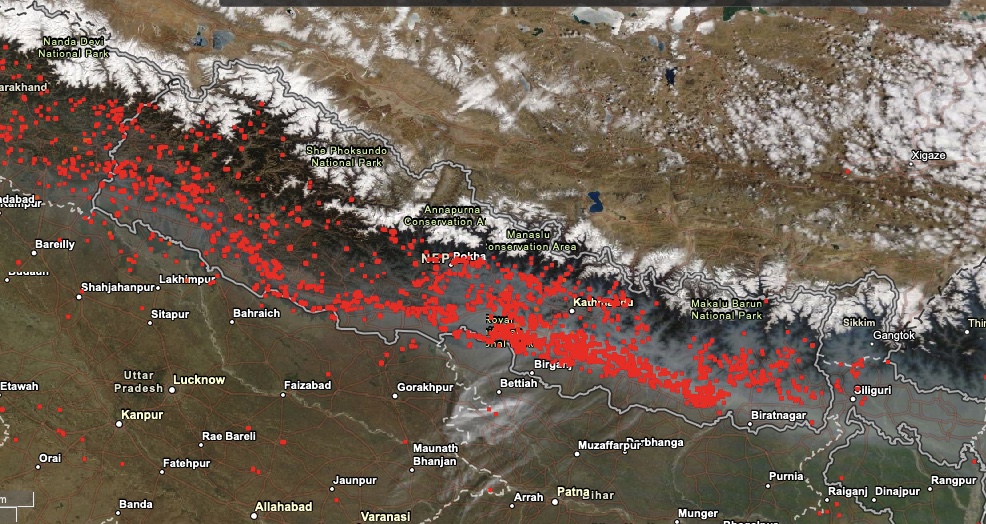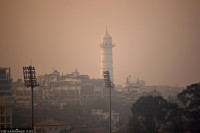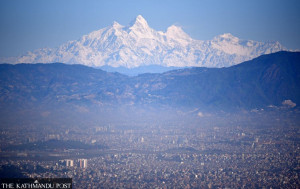Climate & Environment
Haze and smoke turn Kathmandu most polluted, low visibility affects flights
Unprecedented fires after prolonged drought across the country and winds partly responsible, meteorologists say. With wildfires peaking in April, worse may be yet to come.
Chandan Kumar Mandal
Smoke and haze covered Kathmandu and some other hilly areas for most of Friday, with the weather condition becoming more severe in the afternoon.
As the air quality deteriorated, Kathmandu became the most polluted city in the world in the afternoon.
With visibility at just 1,000 metres, Tribhuvan International Airport was closed from 2:10pm.
“The atmospheric condition has been hazy. There is haze, with a mixture of smoke in the atmosphere,” said Raju Pradhanang, a senior meteorologist at the Meteorological Forecasting Division under the Department of Hydrology and Meteorology. “Raging wildfires could also be one of the factors. We have not confirmed that though.”
Nepal witnessed a relatively hot and dry winter as the country received only 25 percent of normal rainfall in the season. With scant rainfall in three winter months (December-February), the country experienced a severe drought-like situation, which is a recipe for wildfire.
The dry condition has ushered in one of the deadliest forest fires the country has seen of late. Forests are burning across the country.
The Infrared satellite images from NASA’s FIRMS (Fire Information for Resource Management System) showed numerous fires from east to west.

According to Sundar Prasad Sharma, an under-secretary at the Department of Forest and Soil Conservation, the country is witnessing one of the worst forest fire seasons, evidently that a record 479 wildfire incidents were reported on Thursday.
Sharma, who is also the forest fire focal person at the department, said: “It is not limited to one or two districts or a particular region. Forests are burning across the country.”
According to Sharma, forest fires had broken out at 437 places in 54 districts all over the country on Friday afternoon. Most of the fires were recorded in the western districts of Kanchanpur, Banke, Bardiya and Kailali, among others whereas central hill districts and Tarai districts across the country also have fires spreading massively.
As per the data on forest fires accumulated by the Nepal Forest Fire Management Chapter, 524 fires were detected in Nepal in the 24 hours of March 25. On Thursday, an elderly man was killed in a wildfire in Gorkha.
Since the 2015-16 dry season, this is the first time forest fires have been recorded in 73 districts. The record for wildfires during this period was 63 districts in the 2018-19 forest fire season.
Sharma’s data shows there have been 2,087 forest fires in 73 districts between November 15, 2020 and March 25, 2021.
“The number of wildfire incidents has been unprecedented and we are worried about the situation,” said Anil Pokhrel, chief executive officer of the National Disaster Risk Reduction and Management Authority.
The wildfire season in Nepal begins sometime between November and December and continues until the onset of the monsoon. Around 80 percent of wildfire incidents occur between March and April with the last week of April as the peak.
“We are yet to see the worst of wildfires,” said Sharma. “If the weather doesn’t support us, then the country will suffer a massive loss of forests, lives and the property.”
Forest fire incidents were relatively smaller last year when the country was fighting the pandemic. Reports also showed that forest fires had reduced amidst the pandemic.
This could lead to more forest fires this year, according to Sharma.
“The forest fire fuels are dry and have accumulated this year, which can result in more fire incidents in the coming weeks,” said Sharma.
Winter fire begins from mid-November, mostly in the mountain region whereas summer fires begin in March till mid-May and occur in Tarai districts and the mid-hills.
“This year, however, winter fires started earlier. There were wildfire incidents in Manang and Mustang and other districts,” said Sharma. “Besides, fires have been more intense and are more frequent.”
Nepal, which boasts an improved green cover, loses a significant area of forests to wildfire incidents every year. The annual wildfire is considered the leading threat to sustaining the country’s forests area and the biodiversity that it preserves.
Unofficial estimates, according to Sharma, who voluntarily compiles data on forest fires from across the country, show that the country has been losing some 200,000 hectares of forest area annually since 2005.
Besides, at least 106 deaths are reported to have been caused by wildfires since 2005, according to the data he maintains.
The worst forest fire season, in terms of lives lost, in recent years was in 2009 when 49 people, including 13 Nepal Army personnel, died in Ramechhap district while fighting a wildfire.
Meanwhile, some 268,618 hectares of forest cover across the country were lost to fires during the months of January-May in 2016.
In 2016, Nepal lost nearly 1.3 million hectares of forest and 15 people were reported dead in forest blazes, according to Sharma. While 2017 was a Zero Forest Fire Casualty Year, the threats of wildfire and the destruction they wreak remain.
Besides burning valuable natural resources like forest, land and wildlife, forest fires also contribute significantly to air pollution by generating haze and smog, which have a direct effect on human health.
The poor air quality in Kathmandu, for which fossil fuels are mostly responsible, was further exacerbated by the burning forests in nearby districts, topography and wind direction.
“Westerly wind that is blowing from west to east has brought more smoke from western districts, where wildfires are raging,” said Pradhanang, the senior meteorologist. “As the atmosphere is stable, pollutants and smoke have remained trapped inside the Valley.”
With forests burning across the country, the atmosphere in hill areas, including Kathmandu, has become hazy, worsening the air quality in Kathmandu.
IQ Air, a Swiss air quality technology company that provides real-time worldwide air quality data, showed that Kathmandu became the most polluted city in the world on Friday afternoon. The capital city kept on shuffling between the top three positions competing with Beijing and Mumbai.
With the Air Quality Index (AQI) level reaching 198 by 3:45 pm, the air quality level was ‘unhealthy’ for the residents. At 5:45 pm, it further worsened reaching 340, which is considered ‘hazardous’ level.
The PM2.5, the most dangerous pollutant, was recorded highest at 171micrograms per cubic meter (μg/m3) by 9:45 am, showed the IQ Air data. The highest AQI measurement was also recorded at 9:45 am with a reading of 221.
Such a level of pollution means the air quality of Kathmandu was several times higher than the acceptable limit, according to the WHO Air Quality Guideline (10μg/m3).
A three-day forecast of the weather office says the weather in the country’s hilly regions will be partly cloudy. The country has been witnessing massive wildfire incidents in several districts.
According to Pradhanang, the visibility level was reduced to 1,000 metres, whereas a minimum of 1,500 metres is required for regular flight operations.
The hazy weather has already affected flights operating from the Tribhuvan International Airport, which was closed on Friday from 2:10 pm due to haze and smoke.
According to Deo Chandra Lal Karna, a spokesperson for the Tribhuvan International Airport, the disturbance started at 2 pm, forcing eight domestic flights to divert and an international flight coming from Hong Kong to circle the Nepali skies from 3:30 pm.
“The visibility level on Friday afternoon was not feasible for even Instrument Flight Rules, which allow pilots to fly aircraft under instrument meteorological conditions,” said Karna.
Visibility improved to 1600 metres at 4:09 pm, allowing flights to resume.
A Himalaya Airlines flight from Dammam, Saudi Arabia and a Nepal Airlines flight from New Delhi landed at the airport. However, a Cathay Pacific flight from Hong Kong was diverted to New Delhi, the airport authority said.
‘Unhealthy’ level of air quality was recorded also in Butwal, Pokhara, Dhankuta, Bhaktapur on Friday afternoon. Lalitpur recorded a ‘very unhealthy’ quality of air with an AQI level of 270.
“Dust particles had been in the atmosphere. There is smoke as well,” said Pradhanang. “Only if there were rain would the dust particles settle down.”
According to Pokhrel, three agencies—the authority, Ministry of Home Affairs and Ministry of Forests and Environment—have started working under a special programme for combating wildfires in the country.
Sharma has been tasked with leading the mechanism under the Home Ministry for fighting wildlife incidents, according to Pokhrel.
“Such a mechanism never existed before. We have realised that various agencies need to collaborate together,” said Pokhrel. “Sharma’s experience will be used for dealing with wildfire events whereas the Home Ministry has the resources, like security forces, which can be mobilised. Soon, there will be a dedicated action plan too for overseeing wildfire incidents.”
Following the deterioration of the air quality in Kathmandu Valley, which reached an unsafe level on Friday, the Health Ministry issued an advisory to the general public to remain safe and avoid outdoor activities.
“The bad air quality in Kathmandu is also due to forest fires around Kathmandu. In Nuwakot, Rasuwa, Makwanpur and other districts, forests have been burning in the Tarai and mid-hills,” said Sharma.
“We are looking up to the weather for the rescue. Fire incidents will peak around April 25. The number of fires is already crossing the 400 mark. We can’t imagine what will happen at the peak time.”




 17.12°C Kathmandu
17.12°C Kathmandu











